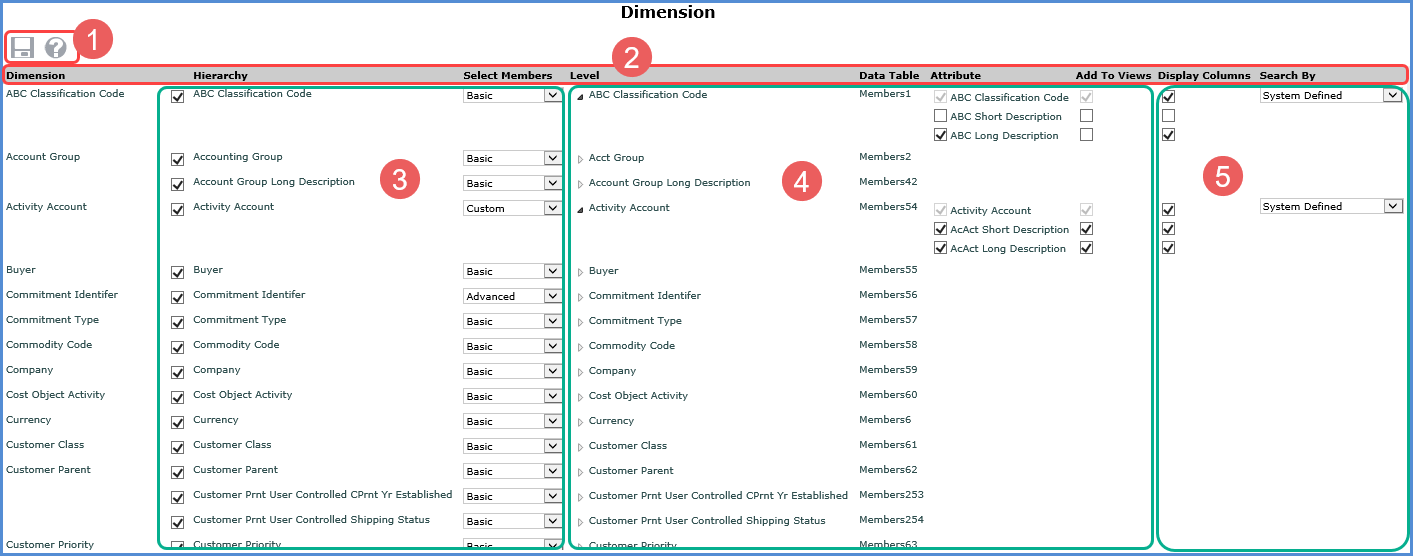

|
Toolbar -
|
|
This window is organized by dimension, hierarchy, level, and attribute relationships. Dimensions are listed alphabetically, including the single Time dimension that contains all time hierarchies. To the right of each dimension are its hierarchies, levels, and attributes along with properties that control their availability in views and some related Select Members windows used for filtering.
|
|
The following settings are used to control which hierarchies are available in views and what type of Select Members search window shows by default while setting up certain types of filters for the applicable hierarchies. Hierarchies And Checkboxes To Control Their Availability – The checkbox next to a dimension’s hierarchy controls whether the hierarchy and its level(s) will be available to use in views.
Note: Changing a hierarchy status from selected to deselected in cases where its used in views already does not impact those views. The hierarchy will still show up in the views that already had it in it, but the hierarchy will not be available to add to other views. Select Members Setting for Hierarchies, Dimensions, and Levels - The Select Members drop-down lists next to hierarchies control which select members window will display when users set up member list filters for levels that belong to the hierarchy. See also item 4 in this table for some other settings that impact the Select Members and Advanced Select Members windows.
Custom - A window customized to your company’s needs will display for member list filter purposes. Custom searches help users find members from large dimensions by allowing searches based on multiple attributes and/or other unique criteria. Contact your Silvon Sales Representative to see an example and for details about how Silvon can create and implement a customized master file search. |
|
The following settings are used to control which attributes for levels are available in views and which attributes will be automatically added to a view when the level gets added to a view. Attributes And Checkboxes To Control Their Availability – Use the checkbox to the left of each attribute to control whether the attribute will be available to use in views.
Note: Changing an attribute status from selected to deselected in cases where its used in views already does not impact those views. The attribute will still show up in the views that already had it in it, but the attribute will not be available to add to other views. Add To Views Checkboxes To Control What’s Automatically Added To Views – Use the Add To Views checkbox to the right of an attribute to determine which attributes are added to views automatically when their level is added to a view.
Note: Changing an Add To Views status from selected to deselected in cases where an attribute is used in views already does not impact those views. The attribute will still show up in the views that already had it in it, but the attribute will not be added to other views automatically. |
|
Levels and their Default Display Columns and Search By Properties - Expand a level to see Search By and Display Column properties. The Search By selection controls what searches default to in the Select and Advanced Select Members windows no matter where the windows are accessed from – be it from views, the User List Maintenance window, the Role Maintenance window, and so forth. Display Columns selections influence displays columns that show when the Select Members, Advanced Select Members, Paste Members, and Select User List Filter windows are accessed from anywhere other than a view (for example, when the Select Members window is accessed from the User List Maintenance window).
Note: When selection windows are accessed from within views, the display columns default to the values and/or attribute relationships showing in the grid. In the case of views with parameters where the windows are accessed from the View Prompt window, display column settings will be influenced by a parameter’s Display Text property. |